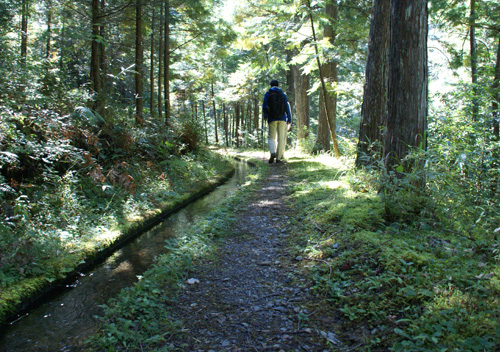
from Japan vol. 62 2012.12.04 Forests hold the key to a sustainable society - Forest therapy initiatives
![]()
“Shinrin-yoku” or forest bathing is a word that was coined in the 1980s, a time when Japan’s rapid economic growth peaked, on the eve of the collapse of the bubble economy. Thirty years have gone by since. “Forest bathing” is now evolving into “forest therapy.” Currently, extensive research is being conducted on the benefits this may have on human health and management of forests have become an important issue. Here brims ideas for what the relationship between man and nature that would help realize a sustainable society should be like and for reinvigorating regions and cities by using forests, in other words, ideas for designing our future. I visited Yusuhara, a small town located in Kochi Prefecture, to learn about “forest therapy” and how the townspeople are utilizing this content.
目次へ移動 A walk through the forest
A young chestnut bobbing down the stream guided us through the forest.

This is a forest therapy road located in the Matsubara district of the town of Yusuhara in Kochi Prefecture. The road is 3km long. Alongside it, you will find irrigation ducts (6km in length), which had been dug approximately 100 years ago. When you are there, you get a pleasant, ethereal feeling that you are walking through the forest with a walking stick made of water in your hand. On the other side, you can hear the limpid stream, one of the tributaries that empty out into the Shimanto River, trickling down the Kubotani Valley.
"The water in the duct flows at the same speed as the blood in a fetus."
Mr. Hiroyuki Shimomoto, a certified forest therapy guide, who took us through the forest explained.
It is hard for those of us who live in urban areas to realize that Japan is a country with an abundance of natural resources. For example, the ratio of land covered by forests to Japan's total surface area is 67%, whereas the percentage for the rest of the world is 30%. This means that Japan has one of the largest forests in the world. The same percentage for Brazil, where you will find the Amazon rainforest, is 57%, and for Canada, which is often thought of as a sylvan nation, it is only 34%.
Kochi Prefecture has the highest forest coverage in Japan of 84%. It is also home to crystal clear waterways such as the Niyodo River, which has the best quality water according to the water quality survey conducted by the Ministry of Land, Infrastructure, Transportation and Tourism (2010), Shimanto River, and Yoshino River. And Yusuhara has an even higher forest coverage of 91%.
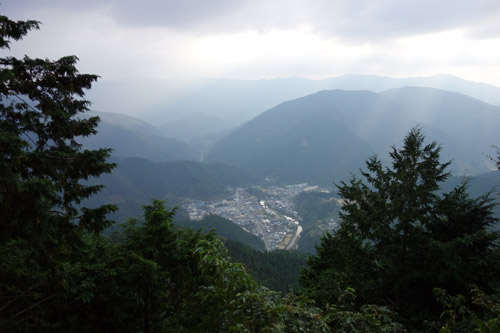 Yusuhara, Kochi Prefecture
Yusuhara, Kochi Prefecture
Yusuhara, often described as a "town above the clouds," is located over 1,000m above sea level, in the center of the Shikoku mountain range. So as you can imagine, the surrounding nature is truly dynamic in scale.
Currently, many inspection teams from nationwide flock to this town. They come to study the town's environment. In 2009, Yusuhara was specified as a "Eco-Model City," which will make efforts to significantly cut greenhouse gases. Of the 13 cities, Shimokawa in Hokkaido Prefecture and Yusuhara were the only 2 town governments that were selected. NPOs and companies have already begun working together to nurture forests in Yusuhara. For example, you will find the pilot project by "more trees" and the ANA (All Nippon Airways) forest in this area.
目次へ移動 Forest therapy - rediscovering the relationship between man and forest
"Forests are where modern man can feel rejuvenated."
Mr. Toru Kono, the Secretary-General of the Forest Therapy Society explained in detail.
Before he became devoted to forest therapy, Mr. Kono worked in brand communication at SONY. He is the godfather of the ever-so-famous Walkman, and during his time at SONY he helped share new lifestyles with people all around the world using the power of technology. Since he left SONY, he has endeavored to propose a new lifestyle in which forests play an important role in enriching people's lives.
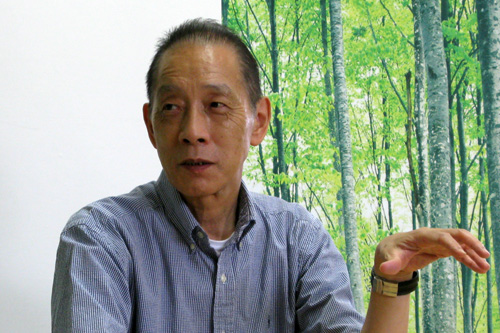 Secretary-General of the Forest Therapy Society, Mr. Toru Kono
Secretary-General of the Forest Therapy Society, Mr. Toru Kono
"Forests" are often chosen as a symbol when discussing environmental issues. This is because forests help create clean water and air, and they are also a treasure house of biodiversity. It is our responsibility, as human beings, to protect forests and to help them grow in size. This will in turn protect the planet. That is why forests are absolutely essential to the realization of a sustainable society.
All around the world, urbanization continues to progress at amazing speed as the economy continues to grow. It is said that by 2030, 60% of the total population or approximately 4.9 billion people will be living in cities. Those of us who live in cities may think of "forests," which are mentioned with environmental issues, as places far removed from "cities."
Even children know that no one owns nature's bounty like the air or water, as soon as people start talking about "forests" in conjunction with land and property, contemporary logic, i.e. "buying/selling," "inheritance" become associated with them. And all of the sudden, although nature should essentially be considered indivisible, it becomes difficult to think of forests that way.
Many people today may think of nature as being isolated from cities. But forest therapy is a way to rediscover the intrinsic relationship between forests and man, to rebuild the relation between forests and mankind in society.
"I believe that forest therapy plays 2 key roles in realizing a sustainable society that also takes the presence of man into account. These 2 roles are: offering preventive mental healthcare that helps reduce stress and preventive physical healthcare, which helps give the immune system a boost by activating, for example, anti-cancer proteins. The Forest Therapy Society helps groom forests so that they will be more user-friendly and to widely promote the power forests have."
The Forest Therapy Society (lead by President Michiko Imai, who is a mountain climber and also a doctor) is an NPO that was established in 2008.
In 1982, the then minister of the Forestry Agency coined the term, "forest bathing." Since then, countless scientific experiments have been conducted to study the benefits the forest environment can have on people's health, and the Forest Therapy Society was established to make use of the quantitative results obtained. There are now 48 forest therapy centers and forest therapy roads in Japan that have been screened, inspected, and recognized.
Before I headed to Yusuhara, Mr. Kono gave me some advice. "What's important is spending some time in the forest. Walking is not the main objective. Just let the forest embrace you."
目次へ移動 Embraced by the forest
Halfway down the forest therapy road located in the Matsubara district, I laid down on the forest floor and looked up at the sky. The forest at first seemed very quiet, but if you listen carefully, you will discover the lively cornucopia of sounds, colors, and smells. As I lay there I thought, "I am being embraced by the forest," but I felt I had to hurry a little as well, because I was keeping Mr. Shimomoto, the forest therapy guide, waiting.
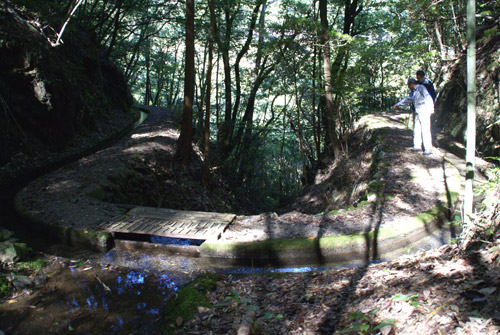
"You can have a little kip there, if you'd like."
Mr. Shimomoto was very kind and knew just what I was thinking. This must be because of his long experience as a certified forest therapy guide.
"There was a visitor who said that he realized for the first time that the land below us is always looking up at the universe like this."
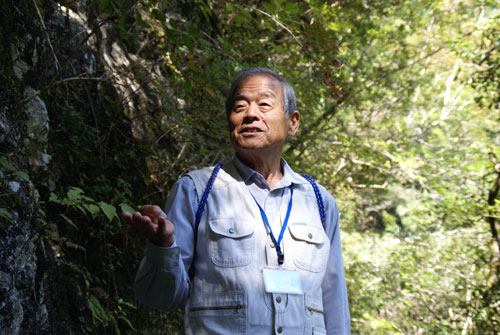 Mr. Hiroyuki Shimomoto, a certified forest therapy guide.
Mr. Hiroyuki Shimomoto, a certified forest therapy guide.
At present, there are 600 certified forest therapy guides in Japan and 400 forest therapists. When traveling, if you know people who live in the area, your can get to know the region much more in depth. Much in the same way, forests help open people up to new experiences.
目次へ移動 Forest therapy and its health benefits
"Forest medicine is still a very new field."
Dr. Miki Gibo is the head physician of the town clinic in the Matsubara district, where the forest therapy road is located.
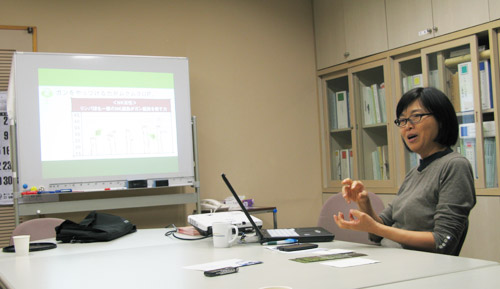 Dr. Miki Gibo, the head physician of the town clinic.
Dr. Miki Gibo, the head physician of the town clinic.
The Matsubara Clinic is mentioned in the series, "Shiroi Kyotou" (written by Toyoko Yamazaki), which began to appear in the weekly magazine nearly 50 years ago, in 1963. Dr. Gibo said, "It must have been a typical small town clinic in Japan back then." But now it is becoming a center of forest medicine that will lead the way for others. This is only possible because of the rich natural resources present in Yusuhara.
Dr. Gibo used illustrated cards to introduce the health benefits of forests.
"What health benefits does forest therapy offer to people's minds and bodies?"
Relaxation
Decreases the level of digestive enzymes known as salivary amylase, which rises when the sympathetic nervous system is put under stress.
Rejuvenates the immune system
Activates natural killer cells that help prevent the development of cancer cells.
Helps treat metabolic syndrome
Decreases the blood glucose level, activates fat-burning hormones that reduce neutral lipids, and thereby reducing abdominal girth.
Anti-aging
Helps increase hormones that decrease with age, and helps keep radical oxygen active and as a result preventing arterial sclerosis.
She showed us statistical data obtained from actual experiments. "The results took us doctors by surprise as well. We weren't expecting such clear results."
The data opened the door to a new path for forest therapy. Now there is medical data available proving that forest therapy has preventive medical benefits. Another unique point is that the anti-aging benefits will continue to last at very high levels even 1 month after experiencing forest therapy.
If there is a lot of greenery, could you enjoy the same benefits in the parks in the city?
"You can't enjoy any therapeutic effect simply by walking on asphalt covered paths surrounding concrete buildings. If you walk through a park with lots of vegetation, you can enjoy some benefits, but not very high therapeutic effects. Change of scenery is important, too. And above all, to get the desired benefits, it is important to be set free of the stress you experience in your every day life, to feel the forest with your five senses, and get good quality sleep at night."
The World Health Organization (WHO) estimates that approximately 5% of the 7-billion global population, or 350 million suffer from mental illnesses such as depression (as of October 2012). In Japan, the number of people suffering from mental illnesses has doubled in the past decade.
"What kind of positive effect do forests have on mental health?"
Research conducted on patients suffering from depression has found that while their anxiety and stress levels decreased, their stress tolerance rose and oxidized cholesterol levels fell.
In 2009, the International Society of Nature and Forest Medicine (INFOM), which conducts research on the effects of forest medicine, was established. In the future, research on the power forests have and the ability of forests to help alleviate or solve issues we face will be conducted more actively, across this global network.
"People living in areas rich in nature lead long, healthy lives."
This has been proven through research on the relationship between mortality rates in cities, towns, and villages and greenery conducted in the United Kingdom and Japan. Because Yusuhara is surrounded by forests, people living in this region are illness free. The forests have helped keep the doctors away. The area also has a very low mortality rate attributable to cancer, and fewer people living in this area require nursing care. In fact, the medical spending for the elderly in this region is about 2/3 that of other areas of the country.
Forty percent of the people living in Yusuhara are aged 65 years and over, so there are many elderly living in this town. The average national population-aging rate is 23%, but if this continues to rise, the national population-aging rate will be over 40% by 2060, approximately 50 years later. That is to say, the age structure of the entire nation will be the same as Yusuhara. As such, Yusuhara, an area truly blessed by the power of forests, may be the utopian dream Japanese society should aspire to bring to life.
People who live surrounded by forests that create beautiful water and air also enjoy other benefits. Forests help alleviate stress and boost people's zest for living. And forests offer much more than just healthy foods as well.
"Your smile becomes even more enchanting if you have a healthy mind and are living a long healthy life."
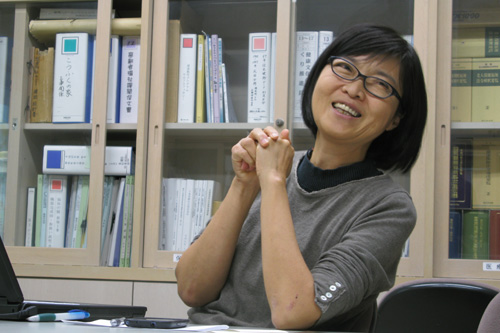
目次へ移動 Yusuhara Marugoto Clinic
I spoke to the mayor, Mr. Tomio Yano, about the initiatives undertaken in Yusuhara and how he positions the forest therapy business.
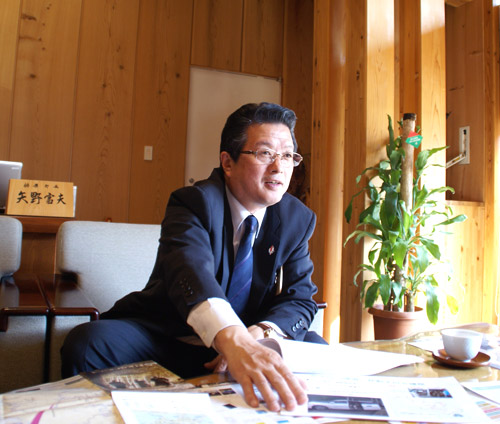 The mayor of Yusuhara, Mr. Tomio Yano.
The mayor of Yusuhara, Mr. Tomio Yano.
"At Yusuhara, we are aspiring to 'create a town that bridges the distance between our homes and the Earth in the 22nd century."
We have just entered into the 21st century, but the town already has a big vision for the next century. But when I spoke to the mayor and talked to the townspeople, it felt as though that vision was already within reach.
"Yusuhara has an abundance of resources - forests, wind, land, light, water, and people - that we can maximize to transform the town's lifestyle into a sustainable one. For example, we can create natural energy using our resources."
Currently, the self-sufficiency of Yusuhara's natural energy is 28.5%. The energy self-sufficiency of Japan, on the other hand, is only approximately 3%. But Yusuhara is aiming to reach 100% by 2050.
One of the ways they intend to achieve this goal is the wind power generation facility operated by the town. The wind turbines that stand on the mountain ridge of the Shikoku Mountain range are in the path of winds from the Pacific Ocean. It is the most ideal location for wind power generation, second to Hokkaido. Plans are underway not only to supply power to the town, but also to sell surplus power and to secure financial revenue.
Many other plans are being implemented at various levels to transform the region's resources such as solar, geothermal and hydraulic power, as well as the resources of the forests into value. If you also take into account the speed of technological revolution, the town may be able to hit its targets ahead of schedule.
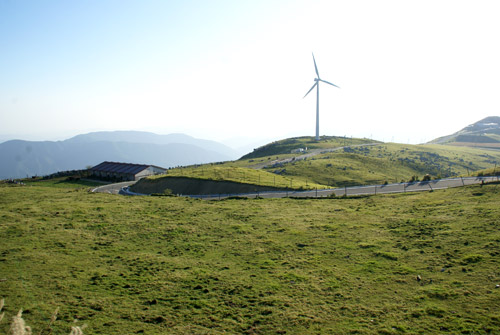 Wind turbines operated by the town located on the karst plateau.
Wind turbines operated by the town located on the karst plateau.
"Transforming our resources into power and gaining autonomy. Becoming autonomous does not necessarily mean becoming self-sufficient. The crux of this concept is 'co-existence' and 'circulation.' Co-existing with nearby cities, towns, villages, the entire Shikoku region, Japan, neighboring countries, and the planet, and encouraging circulation or the development of cycles. It is important to design initiatives for Yusuhara with this in mind."
So where is forest therapy positioned in all this?
"By combining Yusuhara's most abundant resource, forests, with therapy we hope to create content and services that promote co-existence and circulation. Simply having a therapy road in the forest will not give way to co-existence and circulation."
"We must bring to life the 'Yusuhara Marugoto Clinic.'"
Mayor Yano spoke passionately in a Tosa dialect.
"We want to transform our region's resources, mainly our forests where therapy takes place, into value that people who come and visit us can appreciate and enjoy. This means, for example, having people enjoy our seasonal produce prepared by local chefs, producing timber to build life cycle carbon minus homes that emit virtually zero CO2 until they are taken down and having visitors spend nights in these model homes, having visitors enjoy our hot springs, experiencing forest therapy, and getting treated in the clinics. All homes will have an optical fiber Internet connection, so people can receive treatment while working. The entire town will work together, using all the local resources that we have, to help people get well. If Yusuhara is to have value in today's Japanese society, this is what it means. If we can cultivate value, we can learn to coexist and develop circulation, an endless cycle of visitors."
"Yusuhara Marugoto Clinic," which focuses on forest therapy, is also positioned as an initiative that all townspeople can become involved in. Yusuhara does not seem at all like a sparsely populated town in the valley, desperately hanging on to its "environment." Rather, a great energy emanates from the townspeople.
"We want everyone in town involved in realizing a harmonious living that makes use of our local resources and a town that is independent as a result of the various cycles we create."
There are approximately 4,000 people living in Yusuhara, and there are about 1,800 homes. All 4,000 residents are having a hand in creating an environment that enables the town to live in harmony with the forest. Listening to the mayor, I realized that ideas are generated, shared with the townspeople, and executed by all at a truly amazing speed. For those of us, who live in fully developed cities with a complex mixture of values, this situation, where the local government and the townspeople are so close and united, seems worthy of envy. One of the staff working in Yusuhara's town hall said, "We only have 4,000 people, so it's not difficult learning to recognize everyone's faces."
目次へ移動 The forest and its many assets welcome visitors
Perhaps it is the distinctive characteristics of the Tosa region located in southern Japan, but everyone you meet in Yusuhara is bright and cheerful.
In Yusuhara, there is a deeply rooted code of hospitality known as "Maroudo Shingyo" (Maroudo = Visitors, Shingyo = Beliefs). And the organization responsible for forest therapy activities in Yusuhara is called "Yusuhara Maroudo Club."
You will find a small historic teahouse at the entrance of the forest therapy road in the Matsubara district.
Many of the teahouses that still remain in Tosa are said to be the origin of Japan's coffee/tea shop culture. Teahouses used to be places where information was gathered from travelers who stopped by, and the traffic through the mountain path was monitored, but it also served as a social gathering place where people who traveled on foot over long distances could sit and rest, and enjoy light refreshments.
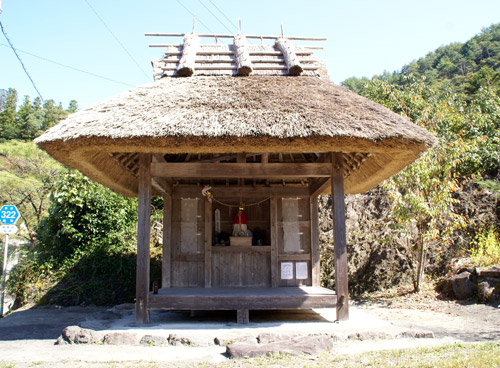 Teahouse
Teahouse
When I went to the town hall, where I spoke to the mayor, I was surprised by the open design of the building. It was like a big teahouse. The wall of the government building created using timber from the town, partitioning the parking lot from the atrium is a gigantic slide door, like the one you may find in an airplane hanger. When the weather is nice, this door is opened up, and the space now connected to the parking lot becomes a large town square. Ventilating the building also improves the energy efficiency of the building itself. (Qualified for the highest rank, "S" of CASBEE/Comprehensive Assessment System for Built Environmental Efficiency).
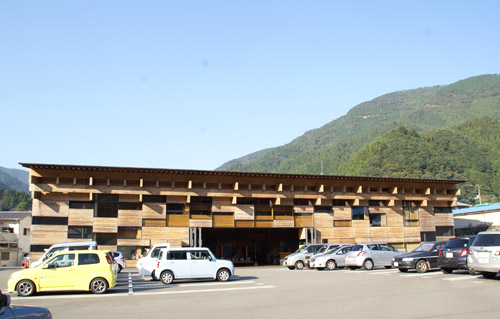 Town hall
Town hall
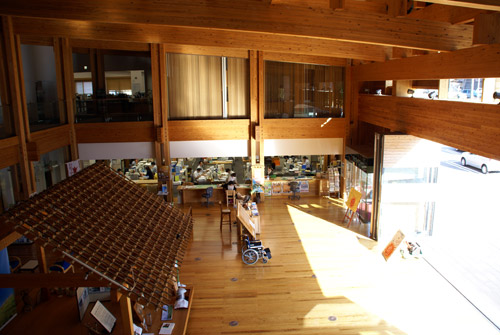 Inside the open architecture.
Inside the open architecture.
The rich forests produce excellent water and air, therefore, the local produce, which the town considers as being one of their local resources, are all very flavorful. Adjacent to the teahouse located at the entrance of the forest therapy road in the Matsubara district, you will find a bakery in the forest named, "Chez Moi." Mr. Shimomoto, the forest therapy guide, also runs an inn called "Sanyutei (Playing in the Mountains)," where you can get "therapy bento (lunch) boxes." At another inn, "Kamikoya," you can experience making traditional Tosa paper. In town, you will find the "Kumonoue (Above the Clouds) Hotel" and "Marche Yusuhara," which has an adjoining local market (the inn is located within the market). So the town has a wide variety of inns ready to welcome visitors who come for forest therapy.
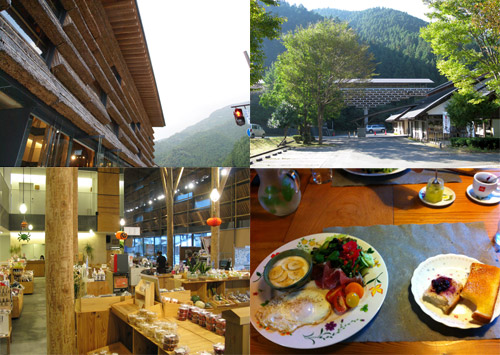
目次へ移動 Cultivating the "forest therapy" brand
Let me return to Mr. Kono, the Secretary-General of the Forest Therapy Society.
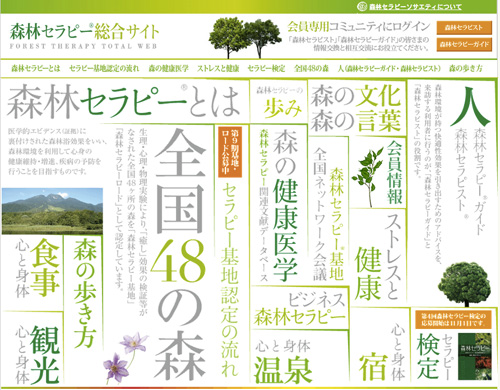 Forest Therapy Total Website (Japanese only)
Forest Therapy Total Website (Japanese only)
It has been 5 years since the Forest Therapy Society was established, but what tasks has he identified in the process?
"There are more forest therapy roads and centers nationwide, so there are more guides and therapists as well. Through public relations efforts, the movement has gained some level of recognition. But these well-groomed environments are located far away from urban areas, where many users live. There may be demand and we may be able to cultivate awareness, but it is difficult to get people to act, so that is something we have to work on."
Mr. Kono explained that although things in Yusuhara are moving forward, there is still a long ways to go.
"We must elevate the power of the forest therapy brand to a level that would give it enough competitive edge to move people into action."
The word "brand" doesn't seem to fit well with the activities of environmental NPOs, but when told that the competitor that is on the other end of the spectrum is Disney Land, it starts to makes sense.
"We think of forest therapy as health care entertainment built on forests and other regional resources."
This is not to say that Yusuhara wants to provide strong stimuli like amusement parks, or to become a type of entertainment that caters to small children and families. But people will not travel the distance simply because you say that it is a good thing to do.
"Places like Yusuhara where the government is taking leadership, people are aware of the importance of forests, that has a long practiced culture of being hospitable to visitors are great, but simply relying on the fact that there are forests in the region or people are passionate will not necessarily result in sustainable activities. You'll just end up like one of the many now abandoned theme parks that were built in rural areas during the bubble era."
In order for forests to play a role in a sustainable society that also takes the presence of man into account, the second phase of forest therapy will need to include 2 key initiatives.
The first initiative is aimed at people who are interested in forest therapy.
This involves developing facilities and services near forest therapy roads that offer benefits that are different from those offered by other tourist destinations, and to emphasize the therapeutic effect and entertaining aspects by also incorporating regional uniqueness. And it would be best if partnerships with medical facilities can be established so that even individuals (and not just large organizations) can take part in such therapy programs and receive medical examinations.
The second initiative will be conducted in partnership with companies.
Companies nowadays are required to provide some kind of treatment to employees who have mental health issues. This initiative will promote forest therapy as a type of treatment for such illnesses. I was told that this initiative would aim to nurture relationships with companies and industrial physicians so that Yusuhara can start welcoming people in need.
"We are hoping that we will be able to create a program that will become a model case example of 'forest therapy,' which will be convincing to people who are in charge of treatment and human resources at companies."
"It takes time and effort to create a system that involves human life and health. It's quite similar to nurturing forests."
Mr. Kono spoke with the same open, carefree smile I saw on the face of people I met in the sylvan town of Yusuhara.
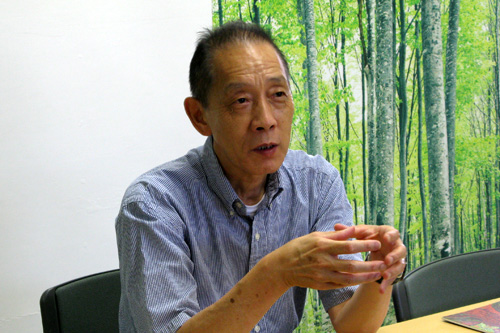
目次へ移動 After my visit
The rain that began to fall on the last day of my visit turned torrential, and I got stuck at the airport. As I stared blankly at the rain beating against the windows thinking about the heavy rains washing clean the forests of Yusuhara I explored a few hours ago, 2 thoughts occurred to me.
The first thought was about how Panasonic was the first company in Japan to implement the "2-days a week off" policy in 1965. Even Panasonic's labor union was skeptical about this new policy, and although the Olympic Games had just ended and Japan was suffering from the worst post-war recession, the policy was implemented as announced. The founder, Konosuke Matsushita, did not only want to improve the quality of life of his employees. He also believed that if employees used the extra day off to educate themselves or to get healthy, this would not only be beneficial to the individual, but it would also help better society as a whole.
It is not surprising that this visionary, who also believed that "A company is a public entity of society," implemented this radical policy. One company's idea changed the way of life for an entire society. Social capital is on the same plane as initiatives implemented by companies, so I hope that business leaders like Konosuke Matsushita, who are able to implement policies that not only take into consideration short-term gains and losses, but long-term benefits to society, will begin to incorporate "forests" in an innovative way.
The second thought was about the domestic football league in Japan, the J-League, which was established 20 years ago, in 1993. J-League aims to contribute to society by nurturing a "new sporting culture rooted in community based sports." Saburo Kawabuchi was inspired by the sports facilities he saw in Sportshule, Germany, when he traveled to the region as a football player, which led him to created the J-League.
Like Japan, Germany's economy suffered a devastating blow having lost the war, and since the national government lacked resources for providing sufficient social security, it promoted sports that did not require a lot of funding to help better citizen's health. This has encouraged the development of Sportshule. In Germany, numerous activities are being undertaken to promote forest medicine, and the relationship between forests and health. Key factors that contribute to this are: social health insurance, which covers treatment, and people's legal right to take a 3 week vacation once very 4 years. I hope that in Japan, too, we will be able to transform forests, a widely available regional resource, into something valuable that contributes to improving citizens' health.
I boarded the plane with these thoughts in my mind, but after one short hour I was back in Tokyo.
Once back in the city, my creative wellspring for the potential of forests began to diminish, and the "connection" I had seen began to fade, but change was certainly, and very energetically taking root in many places.
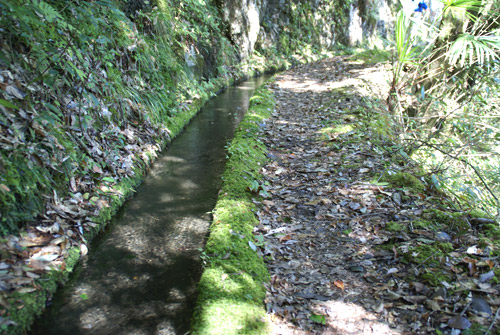
Related URL (Japanese only)
Forest Therapy Society
http://www.fo-society.jp/
Information about forest therapy in Yusuhara
http://www.fo-society.jp/quarter/chugoku/yusuhara.html
Matsubara Maroudo Group blog, "Stories about the forest"
http://matsubara-forest.blogspot.jp/
Forest brand-building reference book
"SONY no furimite wagafuri naose (Observe and learn from SONY)."
Report by: Kentaro Konishi (Think the Earth)
Photography by: Tomoyuki Yamaguchi (Think the Earth)
Translated by: Yuri Morikawa (oxygen inc.)















